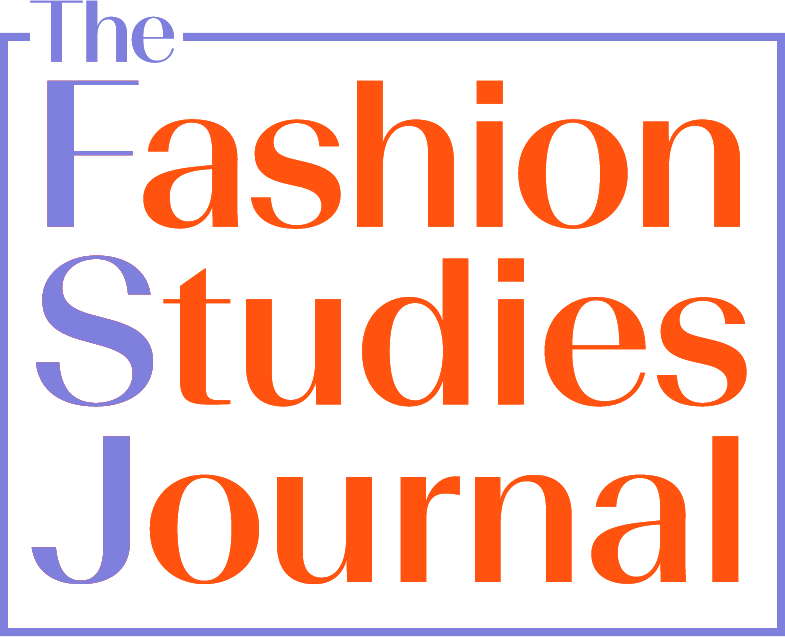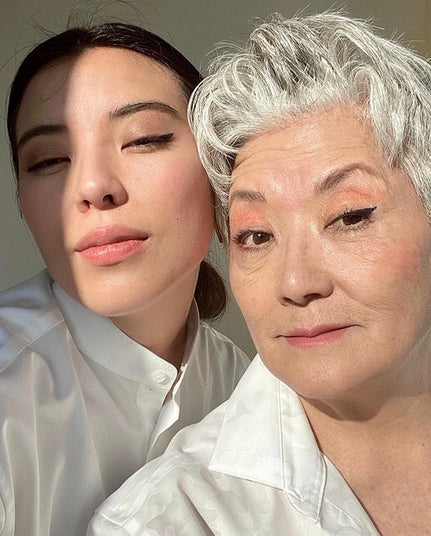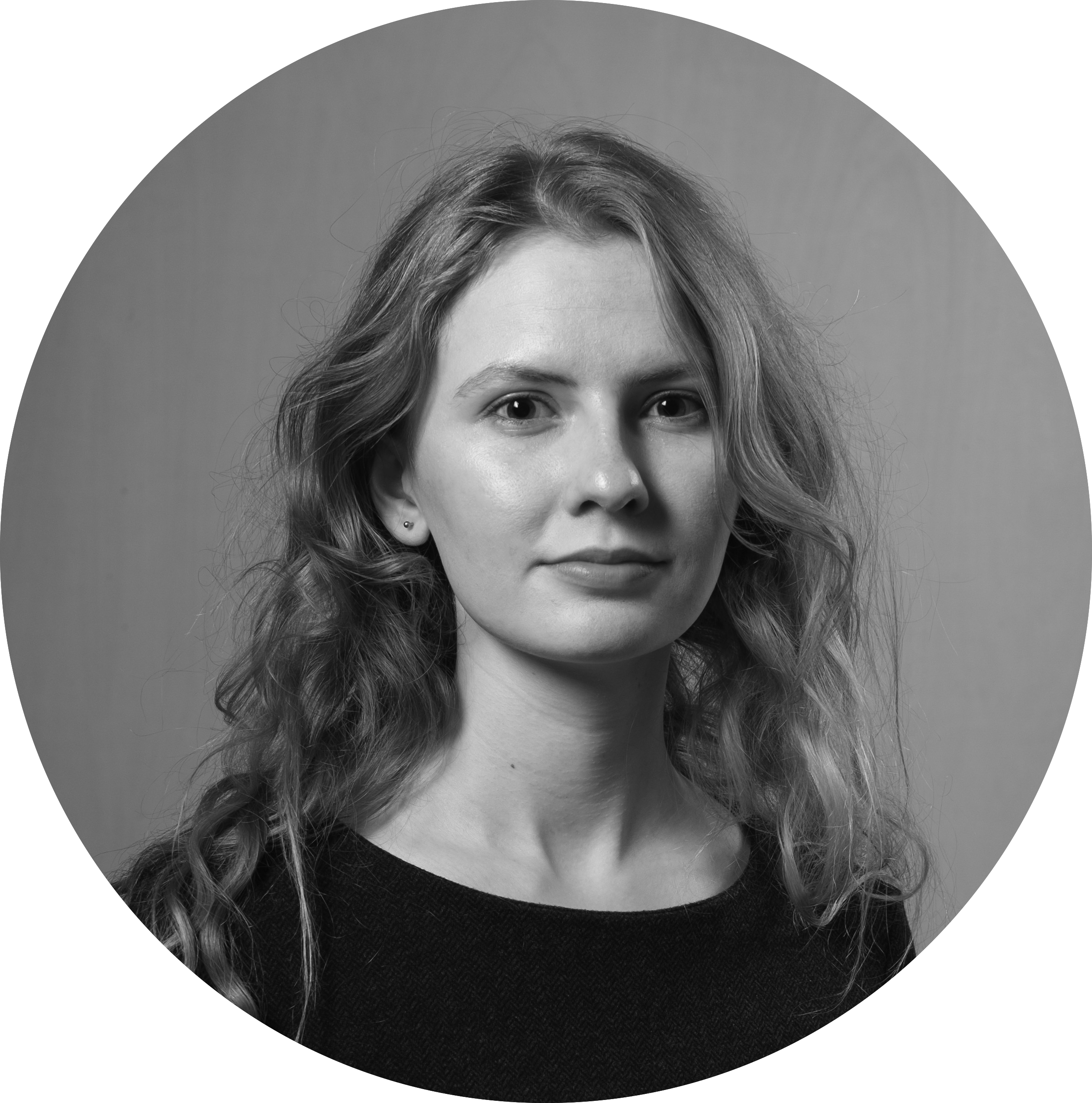
Katherine Shark is an MA student in Fashion and Textile Studies at F.I.T. She is a seamstress, library worker, and aspiring conservator and fashion historian, exploring the social and personal impact of fashion, as well as the technical history of patterning and design.
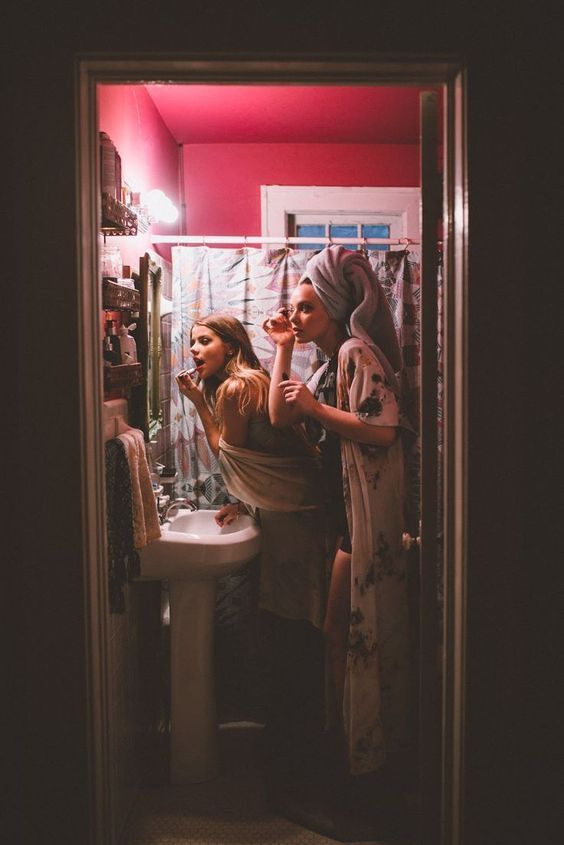 Savannah and Casey getting ready to go out together, 2017.
Savannah and Casey getting ready to go out together, 2017.Fashion serves as a tool both to subjugate - upholding visual hierarchies of white supremacy, promoting consumerist lifestyles, and delineating social stratas out of materialism and exclusion - as well as a source of empowerment and self discovery - clothing as armor, as identity, as comfort against a hostile environment, as a personal touchstone of security and power. Dominant social groups utilize fashion to reinforce their status in the hierarchy, while subjugated groups mimic these aesthetics in order to access power, or actively subvert and resist these arbitrary fashion norms to assert their own power and value outside of the social hierarchy, as discussed by Elizabeth Wilson.[1] Social media has exacerbated this effect of fashion as a status symbol - there is a near-infinite roster of aspirational lifestyle influencers, unboxing Chanel and Hermès, doing Shein and Zara hauls, making Pinterest montage aesthetics - “that girl,” “cocotte,” “rockstar girlfriend.” These ever-increasingly niche aesthetics, rooted in fashion, allow one to literally buy a sense of self (at least temporarily).
While this analysis is critical for our understanding of fashion, it views fashion through the lens of an object - a specific shirt, a certain pair of pants, a brand of shoes, a particular color or accessory. But fashion is more than an object; it’s an action. Fashion is a moment in time, a daily practice - time spent every morning and every evening, the ritual of dressing and preparing for the day, the curation and analysis of shopping, and even time spent creating. As the hosts of the podcast Dressed, April Callahan and Cassidy Zachary, say - “With over 7 billion people in the world, we all have one thing in common. Every day, we all get dressed.”[2] This daily practice can be a period of individual reflection, an anxiety-inducing preparation for performance, and critically, an opportunity for social bonding. Fashion is not a solo activity - for so many of us, the time we spend getting dressed can be an important moment of connection and community with others. Marginalized people exist in a world that thrives on our isolation and alienation, from our bodies and from one another; finding connection, community, and joy through the ritual of fashion becomes an inherently political act of resistance.
For many of us, this starts young, specifically with a relative, often one’s mother. So many people can recount their early memories of watching their mother get dressed for a dinner or a party - picking an outfit, applying lipstick, putting on earrings, spritzing perfume. So many of us can also recount an immediate second memory of sneaking into our mother’s closets and makeup kits in an attempt to imitate her - playing dress up, smearing lipstick, losing earrings, spilling perfume. We want to be like our mothers, our aunts, our sisters - we want to join in on their preparations.[3] This experience is not exclusive to women - even those who did not feel compelled to experiment with their relative’s clothing and makeup can probably remember having their clothing straightened by a parent, having someone help pick an outfit for a formal occasion. The memories of these times carry with us into adulthood, often into our own parenthood - my mother taught me how to paint my nails while telling me how her mother taught her to paint hers.
Time spent preparing for formal events
Weddings are famously an opportunity for dressing to be a bonding opportunity, specifically among women. A common Western wedding tradition involves the bride and her bridesmaids preparing for the wedding together in a suite, often wearing matching outfits, getting their makeup and hair done while they wait. The time is focused on the bride, celebrating her and helping her feel her best for her big day. Some Western weddings involve similar rituals for grooms, though often smaller in scale, such as the best man helping him with his cuffs. This period of preparation is not unique to Western Christian weddings, with many cultures having some iteration. Indian weddings famously have a Mehndi ceremony, where female members of both the bride and groom’s families come together to celebrate the bride while she has henna designs applied.[4] Regardless of cultural background, the gathering of female friends and family members to uplift and celebrate the bride is a critical element of so many weddings, offering advice and good wishes in preparation for the next stage of life.
Even when not preparing for a specific event, many people shop with others. Whether it’s with a romantic partner, a close friend, or a family member, we often ask others to come along and give us input and support while trying on clothing. As a retail worker, I’ve seen countless mother-daughter duos trying on jeans, spouses helping the other pick job interview outfits, and hordes of teenagers selecting homecoming and prom dresses together. Even when people come into a store alone, they often send pictures or call others for input, or spend time discussing with the fitting room attendant to figure out what they feel best in. The time spent shopping is not simply about the object acquired, it is also about the connection you build with others during it.
 Jerry Hall and Anjelica Huston getting ready backstage. https://www.nowness.com/story/on-this-day-in-1956.
Jerry Hall and Anjelica Huston getting ready backstage. https://www.nowness.com/story/on-this-day-in-1956.Time spent preparing as play
There are countless other opportunities for people, often women and other feminized people, to use dressing time as a chance to bond with one another. From teenagers getting ready for a school dance, to college students getting ready for a party, to adults preparing to go out to a bar or club - there are countless opportunities to get dressed and prepare for events alongside one another. This time is energetic, cheerful - music is blasted, makeup palettes litter counters, borrowed clothing covers the bed, mirrors are shared and people take turns helping one another with difficult hairstyles and challenging eyeliner looks. The 1995 film Clueless has one of the most famous makeover scenes of all time - while makeovers can be rightfully criticized for their reinforcement of patriarchal beauty ideals and promotion of consumerism as identity, the scene clearly shows Cher, Dionne, and Tai bonding with one another through this activity, cementing their friendship over getting dressed. Countless other movies involve similar scenes of getting dressed - Legally Blonde shows Elle and her friends bonding over the nail counter, The Devil Wears Prada shows Andy and Nigel cementing their friendship over selecting a new wardrobe, Crazy Rich Asians has a scene centered around Rachel and her friends searching for a wedding guest outfit - the list is endless. Getting ready together is always emotionally charged and an important bonding time. The iconic meme of lesbians doing one another’s makeup, while focusing more on the obvious homoerotic nature of the photo, is not an inaccurate depiction of the physical and emotional intimacy of doing one another’s makeup, regardless of sexual orientation.[5] Carlie Hanson’s song, “Girls in Line for the Bathroom,” captures this camaraderie and concern, the tenderness of women expressing affection and comfort through makeup.[6]
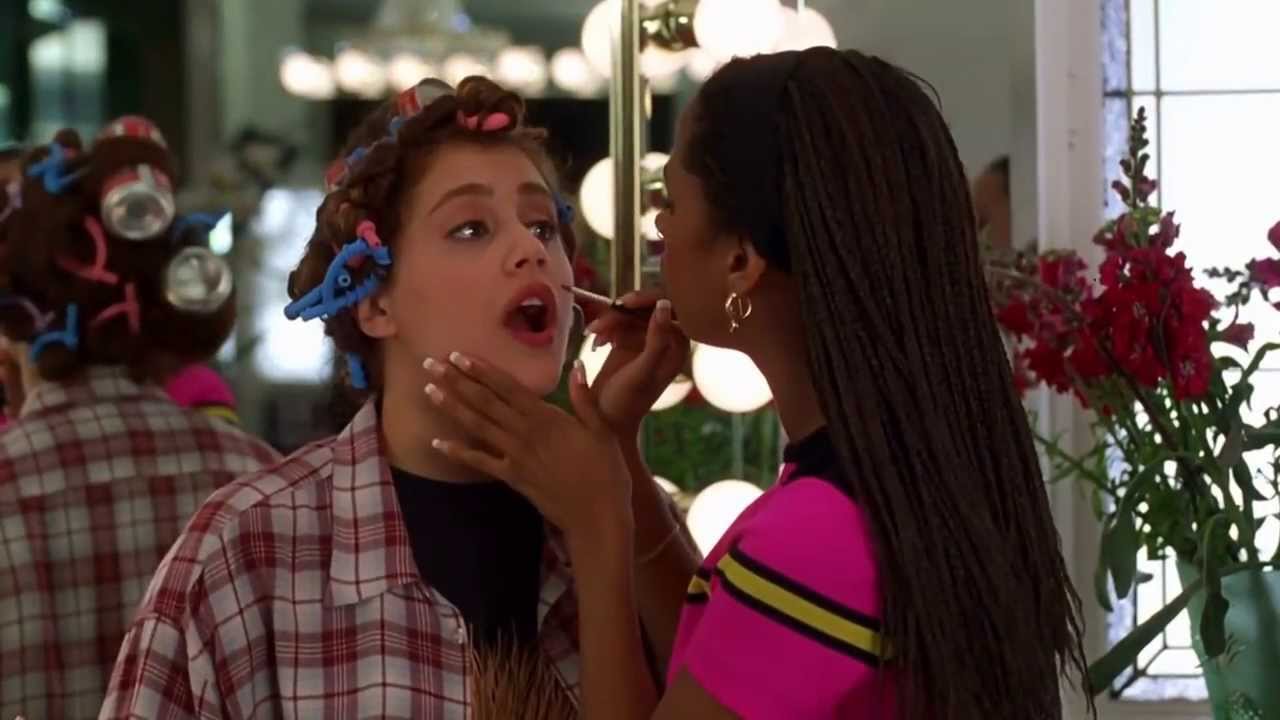
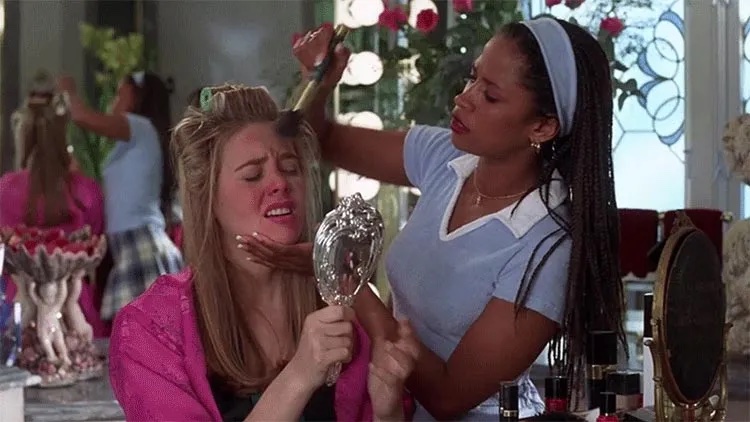
The makeover scene from Clueless; Dion helping Cher prepare for an important date later in the film.
“Fashion as a verb, as an action by which one gets dressed, chooses one’s appearance, and prepares for the day, is a political act.”
From 13-year-olds loaning one another hand-me-down tube tops and experimenting with glittery white eyeshadow for the first time, to 32-year-olds helping one another fasten necklaces, pull up dress zippers, and master the Dyson airwrap, getting ready with friends is a ritual that’s been maintained for generations. This entrenched, almost universal custom is not meaningless or accidental - it provides women with an opportunity to establish and strengthen friendships, enjoying creativity and levity through fashion, providing a critical space of joy and care amongst women, an oasis in a world of hostile misogyny. As an amateur burlesque performer in college, I made some of my closest friends while adjusting costumes and helping fasten garter belts backstage. We bonded not only over sequins and corsets, but through the creative expression and celebration of sexuality, the joy and humor of performing, and the safe space we created for one another to feel beautiful and cherished by others. The act of getting ready with one another gave us the chance to be vulnerable, to feel safe and admired - a political act in a society that has a vested interest in the isolation and rivalry of women.
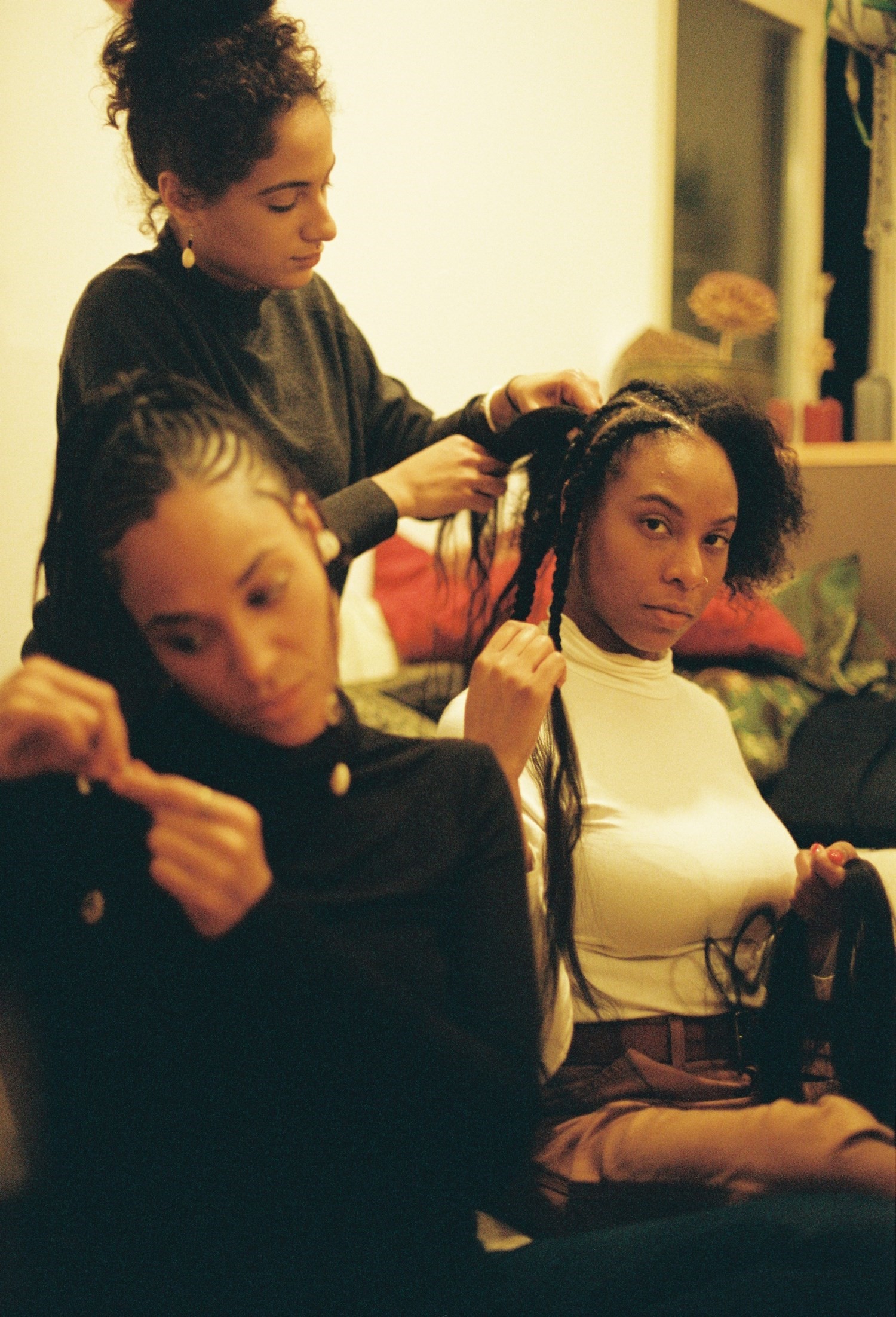
Agatha Powa - “Black hair is beautiful. It’s got so much history. So many shapes and forms. It creates bonds and breaks boundaries which shouldn’t be there in the first place. It’s culture. It can be a political statement. It‘s love; an elder giving their child’s hair the care it needs in order to be healthy. It’s bonding; a reason to meet up with your friends and braid each other’s hair.”
Beauty rituals in Black communities
The time spent getting ready together becoming an act of political resistance and community care is not lost on Black women in America - this is not a new observation.[7] The Black hair salon is “a pillar of Black culture and the Black experience. It is a space completely separated from and impervious to the white gaze. It is not just a destination for hair services, but a cultural ecosystem in and of itself with its own social landscape and underground economy. There's camaraderie and community intimacy shared between chairs…"When I go to the salon, it's to me a lot more about talking to the stylist and talking with the people coming in and out," sociologist Shatima Jones of N.Y.U. says.[8] "When I moved to Greenwich Village, the salon [I frequented] in Crown Heights, Brooklyn was one of the few places where it was mostly just Black women. It was a special place where I didn't have to explain, I could just be a Black woman and not worry about the white gaze. To me, [that’s] the more sort of concerning thing that we might lose when we don't have these spaces."[9]
A study on Black hair salons in the second volume of the journal SSM Qualitative Research on Health, delved further into this, a participant stating,
“ “[It's]a place of peace, even as a place to build, boost your confidence … when my stylist was in a salon, right after they got finished doing people's hair, everybody chime in on how beautiful, you know, that person looked to, you know, to boost them up, to let them know that they are queens. And, you know, every time I got out of that chair, they'd be like, “Girl, you look good. Stuff like that makes you feel really, really good about yourself. And I think that's one of the benefits. The community has that level of peace and confidence when you leave.” [10]
While these reflections focus on beauty and hair, not specifically on clothing, they still underscore the inherently political nature of this time engaging with personal aesthetics and with community - these spaces and the time spent there become a source of resilience, respite, and power for the women there. To care for oneself and to care for others, in a society so intensely hostile to one's existence, is fundamentally an act of political resistance.
 Vincent Ferrané’s Every Day photo series. https://i-d.vice.com/en/article/epdzx4/intimate-portraits-of-the-trans-and-non-binary-community-in-paris
Vincent Ferrané’s Every Day photo series. https://i-d.vice.com/en/article/epdzx4/intimate-portraits-of-the-trans-and-non-binary-community-in-parisLGBTQIA+ community
The LGBTQ+ community, specifically trans people, are also not new to the concept of dressing rituals being critical acts of power and resistance, as documented in multiple occasions, from Vincent Ferrané’s recent photo series, Every Day, documenting the getting ready routines of seven transgender Parisians, to the film Paris is Burning, which documents the rich underground community of the ballroom scenes in New York in the 1980s.[11, 12, 13] Paris is Burning specifically documents the phenomena of the “house mother” - an experienced drag queen who helps the others in her house, helping prepare and mend outfits, do makeup, and materially caring for them. This role is critical to the survival of so many trans youths- when faced with rejection or outright violence from their families and support systems, the role of house mother provides not only for the physical but the mental support of transgender youths. This action of care, through the ritual of dressing, is inherently political.
Time spent creating
The time spent engaging with fashion can also manifest in the literal creation of garments. In the age of the internet, and with the rise of DIY videos and the wave of new crafters - either knitters, sewists, jewelry makers, leatherworkers, menders, or otherwise - making one’s own fashion is now increasingly becoming an option. The act of making fashion is helping so many people redefine their relationship to their clothing and their own bodies, helping them understand how clothing works, how it fits, and how to alter it to better suit their own needs. It extends and intensifies the amount of time people spend on their clothing - no longer is it 30 minutes shopping and trying on a pair of pants, it’s 3 hours of cutting and sewing and pressing to create them. This fosters not only a sense of pride in one’s work, but a greater respect for the garment, and a greater investment in it. Those who make even just a few rudimentary articles of clothing are less likely to throw them out, and are more capable of seeing the value in the store bought clothing they own.
Even more so than the political impact of people moving away from hyper consumerism, the growing awareness and revival of home sewists, menders, and DIYers has an impact on the way women specifically relate to their bodies through fashion. Fashion has for so long been used to punish and control bodies, a tool for reinforcement of unattainable Western beauty standards rooted in white supremacy, not least of all extreme thinness. By learning how to sew and alter clothing, many women are able to combat the way fashion has been used to foster disconnect with our own bodies, and instead become more connected to our physical forms. Learning how to see fashion as a craft and a practice allows women to break the mindset of quantifying self worth through arbitrary and unreliable sizes and instead see skill, time, and care in clothing. Investing time in the practice of fashion allows us to see our bodies and the clothes we put on them as opportunities for comfort, craftsmanship, and creativity, rather than a site for patriarchal control. And perhaps most critically, the clothes created often fit better than store-bought garments, making one feel more at ease and comfortable in our own bodies. Making clothing that fits, and seeing clothing as a puzzle to solve for your own comfort, rather than seeing your body as an unruly object to be disciplined into a certain size, forces a reconsideration of our bodies. Poorly fitting garments are an issue with the garment, not ourselves, and being able to sew allows us to see that.
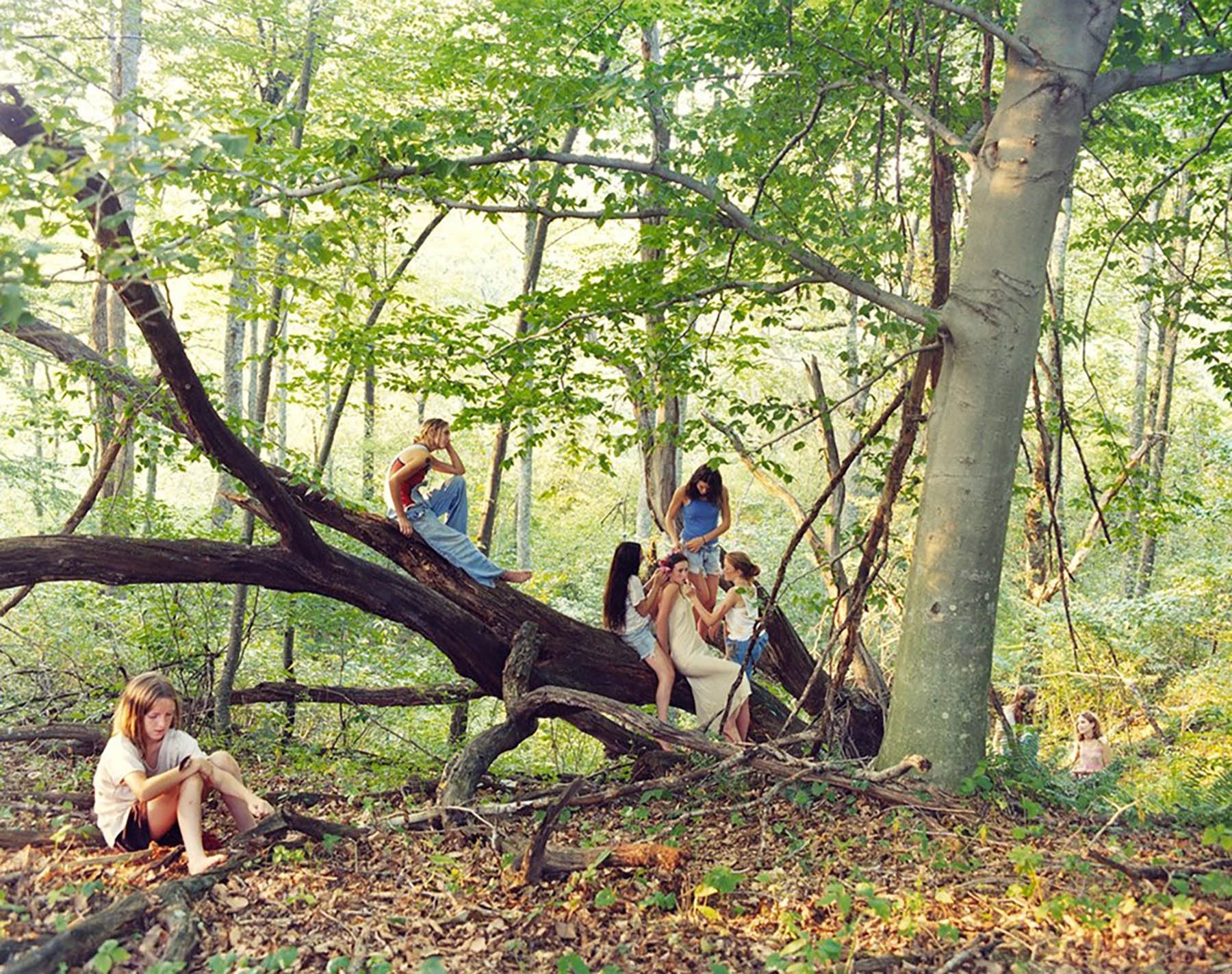
 Justine Kurland, Girl Pictures.
Justine Kurland, Girl Pictures.
Justine Kurland’s Girl Pictures, shot between 1997 and 2002, documents teenage girls in various settings, encountered along a road trip, living their lives with startling honesty.[14] One of these photos stands out, from 1997 - 3 girls in a public bathroom: one standing halfway dressed, one smoking while reading, propped on top of a sink, the third also partially undressed, sitting on the ground amongst a pile of clothes and shoes. White t-shirts dry along the edge of the sinks. The remains of the day are within the crumpled, dripping clothing. This image captures the engagement with clothing that we all have, born out of universal necessity, the transient moment of preparation or recovery in dressing. While it may not be the capital F, magazine fashion we think of when discussing aesthetics, it captures an ease and camaraderie between these girls, in the lull of their task of dressing.
Fashion as a verb, as an action by which one gets dressed, chooses one’s appearance, and prepares for the day, is a political act. While this can have a negative impact - from the internalized panopticon of body checking, obsession, and anxiety over appearance, to the endless hours spent using fashion to perform an identity via social media - it also has the potential to be an empowering and fulfilling moment of bonding with friends, praising and sharing with one another, and building invaluable connection, creating much-needed spaces of care and vulnerability.
As we discuss fashion as a political tool, both of oppression and resistance, we must consider the daily time invested in engaging with fashion and aesthetics. Structures of capitalism, white supremacy, and patriarchy all thrive upon the alienation of marginalized people - LGBTQIA+, people of color, women, disabled people - from our own bodies, from our own identities, trapping us in cycles of consumerism and manufactured need. In the face of this, the daily act of dressing is an opportunity for resistance, a practice of care for ourselves and for others, an opportunity to reconnect with our bodies. While it is not easily defined by traditional academic means, it is the foundation of our relationship to fashion, as individuals and as communities. Whether alone or in a group, for a 9 to 5, a wedding, or even for play, the time spent getting dressed is an opportunity to show care for ourselves and for our friends, family, and loved ones, expressing affection, joy, protection, and creativity. The bonds we build with one another through the ritual of dressing are critical tools of political resistance, in a world with a vested interest in our destruction.
Notes: Between the Public and Private
[1] Wilson, Elizabeth. Adorned in Dreams: Fashion and Modernity. Bloomsbury Visual Arts, 2020.
[2] Callahan, April and Zachary, Cassidy. Dressed: the History of Fashion. Podcast Audio. https://www.iheart.com/content/about-dressed-the-history-of-fashion/.
[3] Heti, Sheila, Heidi Julavits, & Leanne Shapton (eds.). Women in Clothes: Why We Wear What We Wear. Particular Books, 2014.
[4] Parvez, Bisma. “Everything You Need to Know about the Mehndi Party.” Brides. Brides, January 24, 2022. https://www.brides.com/mehndi-party-5075519.
[5] “Lesbians Doing Makeup.” Know Your Meme, July 21, 2022. https://knowyourmeme.com/memes/lesbians-doing-makeup.
[6] YouTube. YouTube, 2022. https://www.youtube.com/watch?v=WrI1Uz4Nu2k&t=60s&ab_channel=CarlieHanson.
[7] Correspondent, NNPA Newswire. “The Black Beauty Industry–a Backbone of Our Community.” AFRO American Newspapers, January 25, 2022. https://afro.com/the-black-beauty-industry-a-backbone-of-our-community/.
[8] Gallatin, NYU. “Shatima Jones.” Shatima Jones > Faculty > People > NYU Gallatin. Accessed December 27, 2022. https://gallatin.nyu.edu/people/faculty/sj63.html.
[9] McNab, Kaitlyn. “Why Some Black Women Have to Travel for Hours to Get Their Hair Done.” Allure, August 24, 2021. https://www.allure.com/story/black-hair-deserts.
[10] Palmer, Kelly N.B., Abidemi Okechukwu, Namoonga M. Mantina, Forest L. Melton, Nidal A-Z Kram, Jennifer Hatcher, David G. Marrero, Cynthia A. Thomson, and David O. Garcia. “Stylists' and Clients’ Perspectives of the Black Salon-A Qualitative Study Guided by the Settings Approach Theory.” SSM - Qualitative Research in Health 2 (2022): 100029. https://doi.org/10.1016/j.ssmqr.2021.100029.
[11] Tsatsas, Lou, Anaïs Viand, and Marie Moglia. “Non-Binary Rituals and Reflections: ‘Every-Day’ by Vincent Ferrané.” Fisheye Magazine, February 3, 2021. https://www.fisheyemagazine.fr/en/scheduled/book/reflets-et-rituels-non-binaires/.
[12] Cresswell, Joanna. “These Photos Celebrate the Sacred Ritual of Getting Ready to Go Out.” The Sacred Ritual Of Getting Ready To Go Out, November 12, 2021. https://www.refinery29.com/en-gb/trans-nonbinary-getting-ready-photos.
[13] Paris Is Burning, 1990. https://www.imdb.com/title/tt0100332/.
[14] Vanderhoof, Erin. “Another Look at Justine Kurland's Girl Pictures.” Vanity Fair, May 7, 2020. https://www.vanityfair.com/style/2020/05/justine-kurland-new-book-girl-pictures.
Image Citations
McNeill, Savannah, Hey. “Renovation: How We Made Our Tiny Bathroom Seem Bigger.” Hey Wanderer (blog), October 5, 2017. https://www.heywandererblog.com/2017/05/before-and-after-downstairs-bathroom.html.
“Marcela & Norma.” 19/99 Beauty. Accessed May 14, 2023. https://1999beauty.com/blogs/conversations/marcela-norma.
“On This Day in 1956 Supermodel and Studio 54 Icon Jerry Hall Is Born.” NOWNESS. Accessed May 14, 2023. https://www.nowness.com/story/on-this-day-in-1956.
“Clueless Makeover.” YouTube, October 13, 2013. https://www.youtube.com/watch?v=EJQPpD4EN00.
Andrews, Arden Fanning. “The Clueless Beauty Rules: Your GIF Guide to Becoming a Total Betty.” Vogue, July 19, 2018. https://www.vogue.com/article/clueless-anniversary-beauty-rules-gifs.
Dazed. “10 Unsigned Photographers Capture Black Hair around the World.” Dazed, January 22, 2020. https://www.dazeddigital.com/beauty/article/47598/1/thursdays-child-black-hair-photographers-global--unsigned-cary-fagan
Moroz, Sarah. “Intimate Portraits of the Trans and Non-Binary Community in Paris.” i-D. Accessed May 14, 2023. https://i-d.vice.com/en/article/epdzx4/intimate-portraits-of-the-trans-and-non-binary-community-in-paris.
Flanagan, Rosie. “Justine Kurland Captures a ’90s State of Becoming.” IGNANT, July 2, 2018. https://www.ignant.com/2018/07/02/justine-kurland-captures-a-90s-state-of-becoming/.
Fashion as a verb, as an action by which one gets dressed, chooses one’s appearance, and prepares for the day, is a political act. While this can have a negative impact - from the internalized panopticon of body checking, obsession, and anxiety over appearance, to the endless hours spent using fashion to perform an identity via social media - it also has the potential to be an empowering and fulfilling moment of bonding with friends, praising and sharing with one another, and building invaluable connection, creating much-needed spaces of care and vulnerability.
As we discuss fashion as a political tool, both of oppression and resistance, we must consider the daily time invested in engaging with fashion and aesthetics. Structures of capitalism, white supremacy, and patriarchy all thrive upon the alienation of marginalized people - LGBTQIA+, people of color, women, disabled people - from our own bodies, from our own identities, trapping us in cycles of consumerism and manufactured need. In the face of this, the daily act of dressing is an opportunity for resistance, a practice of care for ourselves and for others, an opportunity to reconnect with our bodies. While it is not easily defined by traditional academic means, it is the foundation of our relationship to fashion, as individuals and as communities. Whether alone or in a group, for a 9 to 5, a wedding, or even for play, the time spent getting dressed is an opportunity to show care for ourselves and for our friends, family, and loved ones, expressing affection, joy, protection, and creativity. The bonds we build with one another through the ritual of dressing are critical tools of political resistance, in a world with a vested interest in our destruction.
Notes: Between the Public and Private
[1] Wilson, Elizabeth. Adorned in Dreams: Fashion and Modernity. Bloomsbury Visual Arts, 2020.
[2] Callahan, April and Zachary, Cassidy. Dressed: the History of Fashion. Podcast Audio. https://www.iheart.com/content/about-dressed-the-history-of-fashion/.
[3] Heti, Sheila, Heidi Julavits, & Leanne Shapton (eds.). Women in Clothes: Why We Wear What We Wear. Particular Books, 2014.
[4] Parvez, Bisma. “Everything You Need to Know about the Mehndi Party.” Brides. Brides, January 24, 2022. https://www.brides.com/mehndi-party-5075519.
[5] “Lesbians Doing Makeup.” Know Your Meme, July 21, 2022. https://knowyourmeme.com/memes/lesbians-doing-makeup.
[6] YouTube. YouTube, 2022. https://www.youtube.com/watch?v=WrI1Uz4Nu2k&t=60s&ab_channel=CarlieHanson.
[7] Correspondent, NNPA Newswire. “The Black Beauty Industry–a Backbone of Our Community.” AFRO American Newspapers, January 25, 2022. https://afro.com/the-black-beauty-industry-a-backbone-of-our-community/.
[8] Gallatin, NYU. “Shatima Jones.” Shatima Jones > Faculty > People > NYU Gallatin. Accessed December 27, 2022. https://gallatin.nyu.edu/people/faculty/sj63.html.
[9] McNab, Kaitlyn. “Why Some Black Women Have to Travel for Hours to Get Their Hair Done.” Allure, August 24, 2021. https://www.allure.com/story/black-hair-deserts.
[10] Palmer, Kelly N.B., Abidemi Okechukwu, Namoonga M. Mantina, Forest L. Melton, Nidal A-Z Kram, Jennifer Hatcher, David G. Marrero, Cynthia A. Thomson, and David O. Garcia. “Stylists' and Clients’ Perspectives of the Black Salon-A Qualitative Study Guided by the Settings Approach Theory.” SSM - Qualitative Research in Health 2 (2022): 100029. https://doi.org/10.1016/j.ssmqr.2021.100029.
[11] Tsatsas, Lou, Anaïs Viand, and Marie Moglia. “Non-Binary Rituals and Reflections: ‘Every-Day’ by Vincent Ferrané.” Fisheye Magazine, February 3, 2021. https://www.fisheyemagazine.fr/en/scheduled/book/reflets-et-rituels-non-binaires/.
[12] Cresswell, Joanna. “These Photos Celebrate the Sacred Ritual of Getting Ready to Go Out.” The Sacred Ritual Of Getting Ready To Go Out, November 12, 2021. https://www.refinery29.com/en-gb/trans-nonbinary-getting-ready-photos.
[13] Paris Is Burning, 1990. https://www.imdb.com/title/tt0100332/.
[14] Vanderhoof, Erin. “Another Look at Justine Kurland's Girl Pictures.” Vanity Fair, May 7, 2020. https://www.vanityfair.com/style/2020/05/justine-kurland-new-book-girl-pictures.
Image Citations
McNeill, Savannah, Hey. “Renovation: How We Made Our Tiny Bathroom Seem Bigger.” Hey Wanderer (blog), October 5, 2017. https://www.heywandererblog.com/2017/05/before-and-after-downstairs-bathroom.html.
“Marcela & Norma.” 19/99 Beauty. Accessed May 14, 2023. https://1999beauty.com/blogs/conversations/marcela-norma.
“On This Day in 1956 Supermodel and Studio 54 Icon Jerry Hall Is Born.” NOWNESS. Accessed May 14, 2023. https://www.nowness.com/story/on-this-day-in-1956.
“Clueless Makeover.” YouTube, October 13, 2013. https://www.youtube.com/watch?v=EJQPpD4EN00.
Andrews, Arden Fanning. “The Clueless Beauty Rules: Your GIF Guide to Becoming a Total Betty.” Vogue, July 19, 2018. https://www.vogue.com/article/clueless-anniversary-beauty-rules-gifs.
Dazed. “10 Unsigned Photographers Capture Black Hair around the World.” Dazed, January 22, 2020. https://www.dazeddigital.com/beauty/article/47598/1/thursdays-child-black-hair-photographers-global--unsigned-cary-fagan
Moroz, Sarah. “Intimate Portraits of the Trans and Non-Binary Community in Paris.” i-D. Accessed May 14, 2023. https://i-d.vice.com/en/article/epdzx4/intimate-portraits-of-the-trans-and-non-binary-community-in-paris.
Flanagan, Rosie. “Justine Kurland Captures a ’90s State of Becoming.” IGNANT, July 2, 2018. https://www.ignant.com/2018/07/02/justine-kurland-captures-a-90s-state-of-becoming/.
Issue 15 ︎︎︎
Fashion & Southeast Asia
Issue 14 ︎︎︎
Barbie
Issue 13 ︎︎︎ Fashion & Politics
Issue 13 ︎︎︎ Fashion & Politics
